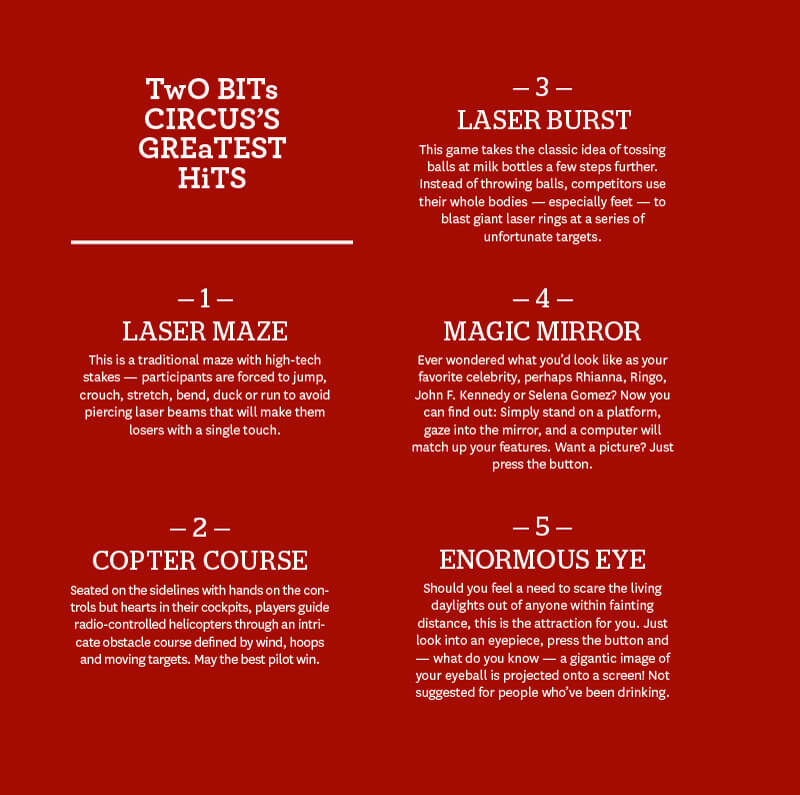Mad Inventor
A murmuring robot on wheels greeted recent visitors to a Port of Los Angeles warehouse. Once inside, the assembled were entertained by a man wearing a silver spacesuit strumming an electric guitar between bolts of lightning timed to the music. Not far away, a squad of future Captain Kirks piloted remote-controlled flying saucers. All of these were framed by a bevy of more traditional amusements, including sword swallowers, fire-eaters and jugglers on stilts.
“I used to have a normal job,” said Eric Gradman, co-founder of Two Bit Circus, the company responsible for this extravaganza, which he calls STEAM Carnival (the acronym stands for science, technology, engineering, art and mathematics). His formal title now is Mad Inventor.
“We’re trying to reimagine out-of-home entertainment,” said Gradman, who graduated in 2002 from USC Viterbi with a bachelor’s degree in computer engineering and, two years later, earned a master’s in computer science.
The Mad Inventor’s “normal” job was building robots for the U.S. military. His real passion, though, was far more basic: tinkering with gadgets in his garage. That’s how Gradman came up with his take on making technology creative: “I realized that what I was producing was art.”
Enter Brent Bushnell, a fellow engineer and former gaming executive enamored of the art and entertainment potentials of technology. Partnered to create amusements for a Los Angeles-based social gathering called Mindshare that both now describe as “a drinking club with an art problem,” Gradman and Bushnell discovered their shared affinity and voilà!—Two Bit Circus was born. “There was simply no way we could go back to real jobs,” Gradman said.
The three-year-old startup, which now employs more than 30 engineers, programmers, mechanics and art designers at its headquarters in downtown Los Angeles, hopes to update and revitalize the amusement industry by, among other things, inventing, producing and selling an array of technological amusements and games; creating and hosting “immersive” private or community events; and producing what Gradman calls “interactive theater” featuring puzzles, performances and video-propelled competitions.
To kick it all off and offer a preview of what’s to come, the two entrepreneurs organized the October carnival in Warehouse 9 at the Port of Los Angeles. Filling 90,000 square feet with dozens of technological games, attractions, performances and workshops, the five-day event attracted more than 13,000 browsers paying $25 a head.
“We wanted to show people a good time and have them leave with an idea of what they can make,” Gradman said. Additional interest has already come from more than 50 cities, including London, he said, sparking plans to take the event international.
Gradman attributes his unusual career, in part, to his experiences at USC Viterbi. “I feel like I got a great engineering education,” he said, “that gave me the skills to build robots and all these other incredible things.”
Ted Faber, a computer scientist at the USC Information Sciences Institute (ISI), remembers Gradman as “one of my favorite” students. “Eric was clearly far more creative and motivated than most undergraduates at USC,” Faber said. “He got involved in every sort of activity on and off campus that tickled one of his broad interests. He is one of a kind, and I could not be happier that he has chosen to devote so much of his time to encouraging others to find the kind of joy he’s found in engineering and art.”
Gradman’s views about the amalgamation of those two disciplines, he said, were shaped by working as a circus performer while attending USC. As an acrobat, aerialist and fire-eater, the future Mad Inventor saw firsthand how magical performance could be. And as a budding engineer, he developed some insights into that field as well. “So often,” he said, “creativity is missing from engineering. At one point I was feeling pretty burned out on it. Combining engineering with performance art was incredibly re-inspiring.”
The inspiration was deepened by the reaction to what Gradman describes as an “awesome” technologically inspired music video he produced in 2011. “Teachers and parents started contacting us,” he said, “and that was the seed.”
At the STEAM Carnival, visitors said they enjoyed Gradman’s unique entertainment offerings. “This is really neat,” said Erin Hutton, who came from Seal Beach in Orange County to experience the carnival with her two sons, Jaiden, 8, and Jayson, 6. “They are putting things together and using their imaginations.”
Ana Ortega, a San Pedro resident who teaches first grade in Los Angeles and has 6- and 7-year-old children of her own, couldn’t agree more. “They have inquiring minds, and this gets their brains thinking,” she said. “They start seeing things as connected to science.”
With so many schools cutting science curriculums, Ortega added, events like the carnival are increasingly critical. “This is very important,” she said. “I hope it catches on.”







